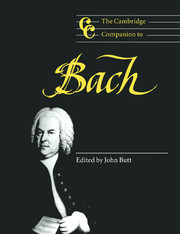Book contents
- Frontmatter
- Introduction
- Part I The historical context: society, beliefs and world-view
- Part II Profiles of the music
- 6 The early works and the heritage of the seventeenth century
- 7 The mature vocal works and their theological and liturgical context
- 8 The instrumental music
- 9 The keyboard works: Bach as teacher and virtuoso
- 10 Composition as arrangement and adaptation
- 11 Bachian invention and its mechanisms
- Part III Influence and reception
- Notes
- Select bibliography
- General Index
- Index of works
9 - The keyboard works: Bach as teacher and virtuoso
from Part II - Profiles of the music
Published online by Cambridge University Press: 28 September 2011
- Frontmatter
- Introduction
- Part I The historical context: society, beliefs and world-view
- Part II Profiles of the music
- 6 The early works and the heritage of the seventeenth century
- 7 The mature vocal works and their theological and liturgical context
- 8 The instrumental music
- 9 The keyboard works: Bach as teacher and virtuoso
- 10 Composition as arrangement and adaptation
- 11 Bachian invention and its mechanisms
- Part III Influence and reception
- Notes
- Select bibliography
- General Index
- Index of works
Summary
According to J. G. Walther's Musicalisches Lexicon (Leipzig, 1732), Bach ‘learned the first principia on the clavier from his eldest brother, Mr. Johann Christoph Bach, formerly organist and schoolmaster at Ohrdruf’. No mention is made here (or in Bach's Obituary, which gives a similar account) of composition, and Johann Christoph is not known to have been a composer. In answer to a query of J. N. Forkel's, Bach's son Carl Philipp Emanuel wrote in 1775: ‘The instruction received by [J. S. Bach] in Ohrdruf may well have been designed for an organist and nothing more.’ The clear implication is that composition was largely excluded.
Here we have a fact of great importance for the understanding of Bach's early development as a composer: unlike his great contemporary G. F. Handel, he seems to have received no formal tuition in the rudiments of composition. His early compositions, most of which are for keyboard, had dual roots: in his own rapidly growing skill as an organist and harpsichordist (‘In a short time he had fully mastered all the pieces his brother had voluntarily given him to learn’); and in his ‘observation of the works of the most famous and proficient composers of his day and … the fruits of his own reflection upon them’.
To judge by the character of Bach's early keyboard works, both the improvisatory and virtuoso aspects of his playing acted as spurs to his creativity. Improvisation was essential to the keyboard player's training in Bach's day, and numerous passages in the early keyboard works no doubt had an extempore basis, notably the free fantasy interludes in the sonata BWV 963 and in the toccatas BWV 910-15 or the ruminative elaborated chord sequences in the preludes BWV 921-3 and in the third section of the toccatas BWV 910 and 913.
- Type
- Chapter
- Information
- The Cambridge Companion to Bach , pp. 136 - 153Publisher: Cambridge University PressPrint publication year: 1997



